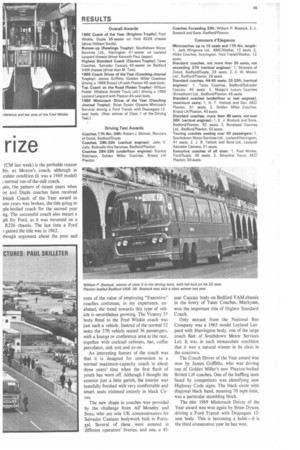Duple coach takes coveted nze
Page 46

Page 47

If you've noticed an error in this article please click here to report it so we can fix it.
A REFRESHING change was the keynote of the 15th British Coach Rally at Brighton last week-end. Several established patterns were broken, and a really new shape was seen in the guise of Portuguese-bodied coaches, one of which won a major award.
For the first time for several years, the coach which won the title National Coach of the Year at Blackpool did not win the major award at Brighton; the vehicle, a Bedford VAS with Plaxton 29-seat body, from the fleet of C. W. Moxon Ltd., was placed second in its class at the concours. The change in the rules at the National (CM last week) is the probable reason his, as Moxon's coach, although in .culate condition (it was a 1969 model) normal run-of-the-mill coach.
ain, the pattern of recent years when on and Duple coaches have received 3ritish Coach of the Year award in late years was broken, the title going to pie-bodied coach for the second year ng. The successful coach also meant a ph for Ford, as it was mounted on a R226 chassis. The last time a Ford gained the title was in 1962.
though argument about the pros and eons of the value of employing "Executive" coaches continues, in my experience, unabated, the trend towards this type of vehicle is nevertheless growing. The Viceroy 37 body fitted to the Fred Winkle coach was just such a vehicle. Instead of the normal 52 seats the 37ft vehicle seated 36 passengers, with a lounge or conference area at the rear, together with cocktail cabinets, bar, coffee percolator, sink unit and so on.
An interesting feature of the coach was that it is designed for conversion to a normal maximum-capacity coach in about three years' time when the first flush of youth has worn off. Although I thought the exterior just a little garish, the interior was tastefully finished with very comfortable and smart seats trimmed entirely in black Cirrus.
The new shape in coaches was provided by the challenge from Alf Moseley and Sons, who are sole UK concessionaires for Salvador Caetano bodywork built in Portugal. Several of these were entered in different operators' liveries, and one, a 45
seat Cascais body on Bedford VAM chassis in the livery of Tates Coaches, Markyate, won the important title of Highest Standard Coach.
Only entrant from the National Bus Company was a 1965 model Leyland Leopard with Harrington body, one of the large coach fleet of Southdown Motor Services Ltd. It was in such immaculate condition that it was a natural winner in its class in the concours.
The Coach Driver of the Year award was won by James Griffiths, who was driving one of Golden Miller's new Plaxton-bodied Bristol LH coaches. One of the baffling tests faced by competitors was identifying new Highway Code signs. The black circle with diagonal black band, meaning 70 mph limit, was a particular stumbling block.
The title 1969 Minicoach Driver of the Year award was won again by Brian Dyson, driving a Ford Transit with Deansgate 12seat body. This is becoming a habit—it is the third consecutive Year he has won.
























































































































